Go  | New  | Find  | Notify  | Tools  | Reply  |  |
| Member |
Why did the military name the M14 rifle "14" since it was to replace the M1 Garand. With my brief knowledge of military firearms are remember the M1, the short lived M2 submachine gun, the widely known and popular M3 grease gun and then the M14. Tried to Google military designation of firearms but did not come up with an answer. In addition, since the M4 is a carbine version of the M-16 why did not the military call at the M 17? These are the questions that keep me awake at night besides my entire life. Any info would be greatly appreciated. Thank you and happy shooting. ----------------------------------------------------------------------------------------------------------------------------------------------------------------------------------------- Democracy is 2 Wolves & a Lamb debating the lunch menu. Liberty is a well armed Lamb! | ||
|
Fighting the good fight |
US Army small arms that were accepted into service during that era (starting in the 1930s) were given sequential model designations. M1 = Model 1, M2 = Model 2, etc. This was a change from the previous method of naming the model after the year of adoption - M1903, M1911, M1917, M1928, etc. If there were variations on a design, these were denoted by subsequent "A" designations - like the M1A1 Carbine. The M1 Rifle, M2 Carbine, and M3 Submachine Gun you mentioned are not all part of the same naming order. The Army broke down small arm designations into subtype - rifle, carbine, SMG, etc. Hence why we have a M1 rifle, a M1 carbine, and a M1 SMG. That's also why the M4 isn't the M17... The M4 is a Carbine, while the M16 is a Rifle. A partial list of the rifles accepted for service from M1 to M14 are as follows. (Some of these are not traditional infantry rifles, like the various spotting and training inserts for recoilless rifles.) And some of the designations are missing, like M3, M10, and M11. I'll check some of my reference material when I get home, to see if I can fill those gaps.
Carbine model designation of the era goes as follows:
SMG designation of the era goes as follows: This message has been edited. Last edited by: RogueJSK, | |||
|
| Member |
Thanks very helpful. ----------------------------------------------------------------------------------------------------------------------------------------------------------------------------------------- Democracy is 2 Wolves & a Lamb debating the lunch menu. Liberty is a well armed Lamb! | |||
|
| Member |
Nicely done Rogue. | |||
|
Fighting the good fight |
Fun side note: If you've never heard of the M2 "Hyde-Inland" SMG, don't feel bad... Most folks haven't. And while it was accepted into service, it was never actually issued or used.   The M2 was designed by George Hyde, the chief gun designer of GM's Inland Division. Hence the name "Hyde-Inland". It was designed to be a cheaper alternative to the Thompson SMG, which was notoriously expensive and time-consuming to manufacture. The M2 was not only significantly cheaper and easier to produce, but it was also about 2 pounds lighter than the Thompson, it was reportedly more reliable in dirt/mud testing than the Thompson, and it was reportedly more accurate than the Thompson due to the in-line stock and slightly slower cyclic rate. The M2 fed from Thompson stick magazines. Hyde's SMG design was tested and tweaked from 1939 through 1942, before being eventually accepted into service as the M2 in April 1942. The M2 was designated as "substitute standard", meaning that it would be produced alongside the standard M1 Thompson as a supplement, though the hope was that the M2 would eventually replace the M1 as the standard SMG. The initial contract for M2 production was given to Marlin, which was supposed to begin production in December 1942. Unfortunately, Marlin had a great deal of difficulty with getting production started, and once they finally began production in March 1943, they continued to run into reliability and functioning problems with the M2s they produced. Marlin only produced ~400 completed M2s before their contract was cancelled in May 1943. At that time, the M2 was abandoned in favor of the even cheaper and easier to produce M3 "Grease Gun" SMG design, which was also designed by George Hyde, and which had been accepted into service in December 1942. So in a way, he made his own design obsolete. (Hyde was also responsible for the design the FP-45 "Liberator" pistol.) Most of the ~400 M2s were destroyed, but a few still exist in museums, and there are a couple of transferrable M2s on the NFA registry.This message has been edited. Last edited by: RogueJSK, | |||
|
| Powered by Social Strata |
| Please Wait. Your request is being processed... |
|
© SIGforum 2025